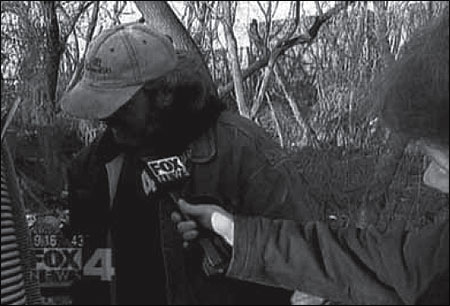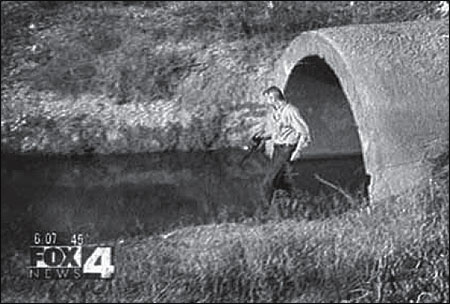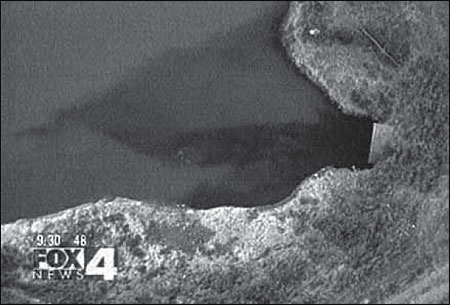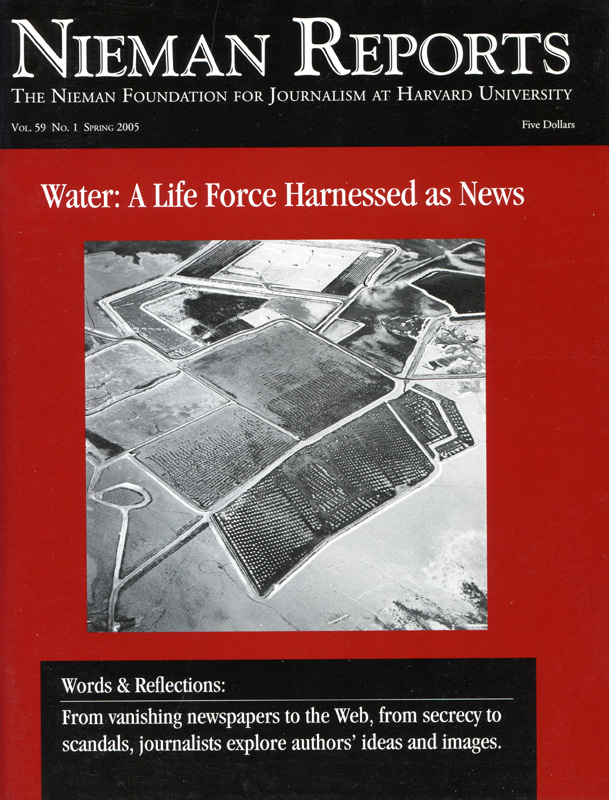
Caught in the Act: KDFW reporter Paul Adrian tries to interview Jimmy Wayne Lashley during an illegal dump.
“You can’t pollute something that’s already polluted,” proclaimed Jimmy Wayne Lashley from the stand at his trial, as he tried to stay out of jail in January 2005. “Who’s going to drink that water?” The water Lashley was referring to was in the Trinity River as it flowed through Dallas, Texas.
Almost exactly one year earlier, KDFW producer Joe Ellis, videographer Paul Beam and I caught Lashley as he dumped hundreds of gallons of portable toilet sewage into a tributary of the river. And we caught him in grand style. Beam, wearing full camouflage, walked up the creek bed prior to Lashley’s arrival and hid on the opposite bank. Ellis and I, along with videographer Phil Fleming, sat in a truck outside the Alliance Sanitation Company’s headquarters. Hovering overhead, another KDFW videographer and our helicopter pilot circled, waiting for a moment we all knew would happen.
We knew it would happen because we had witnessed the dumping three times previously. As usual, on that cold January morning, Lashley was punctual. He used an old Dodge pickup to pull a 500-gallon tank deep into the lot, where it couldn’t be easily seen. Once there, he threw the truck into reverse and backed down ruts created on countless previous trips to the edge of a muddy overhang that dropped down to the creek.
Beam whispered into his cell phone, “he’s getting out the hose … he’s hooking up the hose.” And finally Beam told us, “he’s starting the motor. Come now! Come now!”
Our car roared through the open gates as the helicopter came down toward the site to get the best possible pictures of a stomach-turning operation. A chunky green liquid spewed out of the four-inch wide hose and splashed into the creek.
His pump’s motor made such a racket that it had deafened Lashley. I walked up behind him and got close enough to tap him on the shoulder before he realized the gig was up.
I identified myself as a reporter and asked Lashley what he was doing. He clammed up, but much later he explained to a courtroom jury that “natural purification” would make the material less harmful to the environment. He also said coworkers told him it was an “industry practice” to dump the waste into a creek.
Lashley received as a sentence five months jail time on a case built almost entirely on our reporting.

Hydraulic Fluid Leak: A homeowner describes mystery fluid that flowed onto his property from a Dallas water treatment plant.
Tracking the Polluters
Our investigative team at KDFW, a local Fox owned and operated affiliate in Dallas, had become adept at finding polluters. There is a lot said about how bad water pollution was before the Clean Water Act, and since I wasn’t reporting then, I can’t make a comparison to what we are seeing today. It amazes me how blatantly people still pollute our waters. The Alliance Sanitation lot was not along some secluded rural stream. Rather it sat deep within city limits and shared a border with an interstate highway. Drivers exiting the highway at the right moment could have witnessed a dump in progress.
Our caught-in-the-act video, which we aired as part of our investigation of these illegal dumping practices, was dramatic. But Lashley was not close to being the worst polluter exposed in our news station’s ongoing series of reports, called “Dirty Water, Dirty Secrets.”
A question well worth asking is why a local television news team and not environmental regulators had such success in revealing these polluters. One needs only to examine the regulators themselves to find the answer. What we found is that the quality of regulation depended highly on the identity of the polluter.
In big cities like Dallas, it is the responsibility of city officials to control the amount of pollutants that enter storm water drains and flow into creeks. This work requires both public education and law enforcement. Federal storm water laws cover just about every kind of water pollution that could occur within a city, both from direct sources (people intentionally dumping a contaminant into a storm drain or creek, as Lashley did) and indirect (from pollutants that wash off a company’s property during a storm).
Controlling pollution would be tough for any agency. But it’s made more difficult when top officials have agendas that contradict regulation. Our investigative story was born from the frustration of city inspectors who believed their bosses prevented them from enforcing the environmental laws they were sworn to uphold. With their guidance, we uncovered records that showed the city of Dallas had a double standard when it came to enforcing pollution laws, and this standard was set at city hall. We found small violators were sometimes hit with a huge monetary sledgehammer, while one of the city’s largest and most consistent polluters never received a fine and continued to pollute without fear of repercussion.
That polluter was the city of Dallas itself.
Every city government runs a huge industrial operation. Its sanitation service involves dozens or hundreds of garbage trucks and a landfill. Its water department includes oversight of the city’s water and wastewater treatment plants. There are thousands of cars, such as police vehicles, that are owned, stored and maintained by workers at city facilities and, of course, there is much more.
About two years before we produced our first news story in this series, someone filed a complaint with the storm water inspectors. Oil was spotted in White Rock Creek that flows through one of the nicer parts of town to an urban lake that is the city’s treasure. It’s probably the prettiest outdoor spot in Dallas and is a favorite destination for joggers, boaters and picnickers. The inspectors struggled to figure out where the oil came from, since there’s nothing around the creek but neighborhoods. Then they remembered one industrial facility bordered the creek, a city of Dallas service center, and that’s where they found the pollution. Oil poured off acres of parking lots when it rained, rushing through storm drains, which funneled the pollutants to the creek.
The city has five service centers, where the vast majority of Dallas’s blue-collar workers report for duty. They are also where just about every city vehicle is stored and repaired. The inspectors walked through the sites and documented page after page of violations. They photographed sanitation trucks leaking a mixture of oil, hydraulic fluid and garbage leachate, which pooled and ran down curbs into storm drains. They found oily sludge an inch deep coating parking lots behind garages. Fifty-gallon drums, opened and filled with unknown liquids, littered the back lot at one service center.
Altogether the inspectors documented hundreds of examples of illegal pollution practices. In their reports, they failed the service centers across the board. Any other polluter would have faced thousands upon thousands of dollars worth of fines. But that was not the case for the city of Dallas. The inspectors told us they were prohibited from writing citations for the city, its employees or contractors. One inspector was so frustrated that he added a memo to his inspection report, “Per Jill Jordan, citations cannot be issued to City of Dallas employees.” Jill Jordan is an assistant city manager.
Jordan later explained to us, “It does strike us a little odd that you would ticket one branch of the city, take it out of one pocket and put it in another.” She also said, “that doesn’t strike me as being terribly effective.” She said it was more effective to hire a contractor to clean up the mess and focus city energies on educating the staff so they don’t pollute in the future.
Of course, the argument would have been more impressive had it actually worked. Instead, many months after the inspectors produced their damning reports, we found the same problems still existed at city service centers throughout Dallas. We videotaped lakes of oil pooled in parking lots, streams of sanitation truck leachate running down curbs toward storm drains, and after a rain we photographed oily water billowing off the city’s facility into White Rock Creek. Education had not worked.
Our news stories quickly multiplied; each seemed more preposterous than the last. The head of the water department proclaimed hydraulic fluid was so safe you could drink a pint without harm after we asked him to explain the unreported release of the fluid into a stream by a water treatment plant. The director of the streets department guaranteed me that some 2,000 gallons of liquid asphalt, spilled by the city, could not have reached the Trinity River. He said it would have traveled at most a couple of hundred yards down the storm drain. A few minutes before he told us that, our helicopter pilot reported seeing a huge cloud of material pouring into the river from a 15-foot wide storm drain outfall more than a mile from the spill site. Our pilot said it reminded him of the “Exxon Valdez disaster.” City workers had failed to check the outfall. They also failed to tell the state about the spill as required by law. It seems each department thought another department was responsible for filing the report.
Our city officials, the state, and federal agencies all reacted. The Environmental Protection Agency filed an administrative order against the city for its failures at the service centers. The potential fines were so high that the case got kicked up to the U.S. Department of Justice, which is handling settlement negotiations with Dallas. And the city tackled the problem with manpower and money. The city manager, with the city council’s approval, created 20 new positions: Ten of these new jobs went to create a new office of environmental quality, which is charged with making sure the city follows environmental laws. The other 10 positions went to the storm water inspection team to ensure it has adequate resources to do the job. In addition, the city will spend $12 million during this year and next on infrastructure improvements aimed at making the city more compliant with federal laws.

State Regulators Respond to Story: An environmental investigation leads to a violation notice for Dallas.
The Learning Curve
This story has implications for all of us. At its core, this investigation demonstrated that if anyone should follow the rules, it should be the regulator. Yet my instincts tell me that similar problems exist in most cities. Even after the extensive coverage we gave Dallas on this issue, we’ve been able to find blatant examples of pollution that involve public entities in surrounding communities.
For example, Frisco, an environmentally proud Dallas suburb, changed sanitation contractors and, after it did, the old company picked up all of its rolling garbage bins (some 26,000 of them) and took them to a site designated by the city. There it had a power wash company spray everything on the inside right out onto the ground, including dirty diapers, chemicals stuck to the cans, and whatever trash was left inside. The city administrator in charge of the project was very upset, since she had just been named “environmentalist of the year” by the North Texas Corporate Recycling Association. The sanitation company blamed the power wash company, which admitted failing to control and dispose of the wastewater.
In neighboring Fort Worth, state records clearly document how the subcontractor who picked up the city’s recyclables opened an illegal landfill, which he called a recycling center. It had no permit of any kind from the state as required by law. The city claimed little of its recyclables went to the landfill, but the state records show that Fort Worth Independent School District debris did. It’s documented in two inspection reports seven months apart. The school district hired the contractor to dispose of construction and demolition debris. He sent them invoices from his illegal landfill. District officials claim they had no idea their material polluted an illegal site until we called, even though state regulators had pursued the operator for the previous 18 months.
Reporters ought to be looking at these kinds of stories. Learn the storm water rules, and start driving through any city’s facilities. Is there oily sludge building up on the parking lot behind a mechanic’s garage? That’s illegal. Is leachate and hydraulic fluid dripping off garbage trucks and running down the curb? That’s illegal. Are firefighters washing their trucks at firehouses and letting the water flow into the storm drain? That’s against the law. If city agencies are breaking the law, how can they expect any private entity to follow it?
Sometimes, it seems, reporters can be a bit reluctant to chase environmental stories. Perhaps they are worried about sounding too much like an environmentalist with an agenda. The way I look at this is that I’m an investigative reporter who wants to tell the biggest story possible and achieve the most meaningful outcome. This issue of urban water pollution provides plenty of material for such an investigation with people breaking the law and doing so in ways that produce great pictures and impact a lot of people who live and work downstream.
Here’s my word of caution: Do the story before someone in your market uses the Jimmy Wayne Lashley defense, “You can’t pollute something that’s already polluted. Who’s going to drink that water?”

Giving an Aerial View: A helicopter captures the spill of liquid asphalt into Trinity River.
Paul Adrian is an investigative reporter with KDFW, a Fox owned and operated affiliate located in Dallas. Adrian is also a member of the Board of Directors for the journalism training organization, Investigative Reporters and Editors. He worked on the water pollution series with producer Joe Ellis, videographer Paul Beam, and vice president/news director Maria Barrs.



